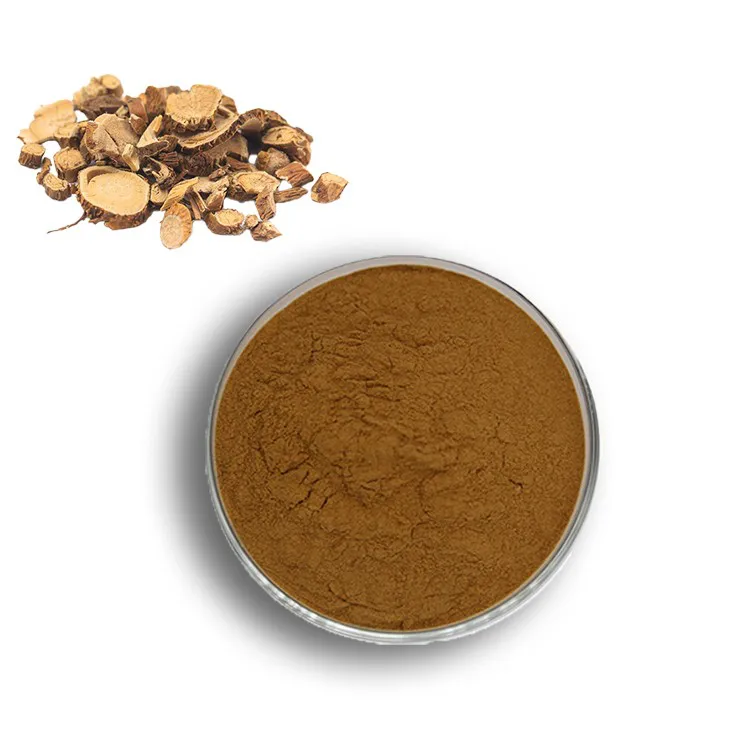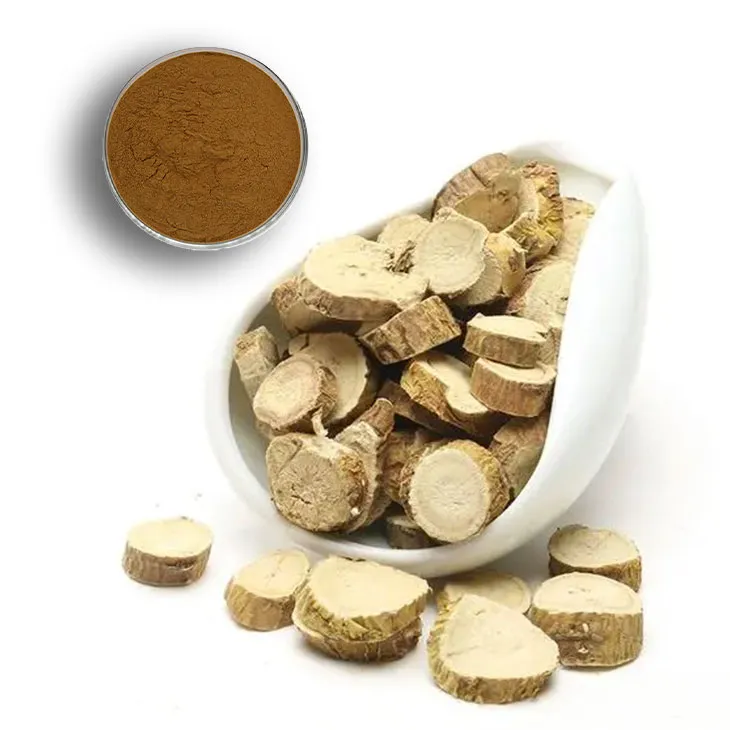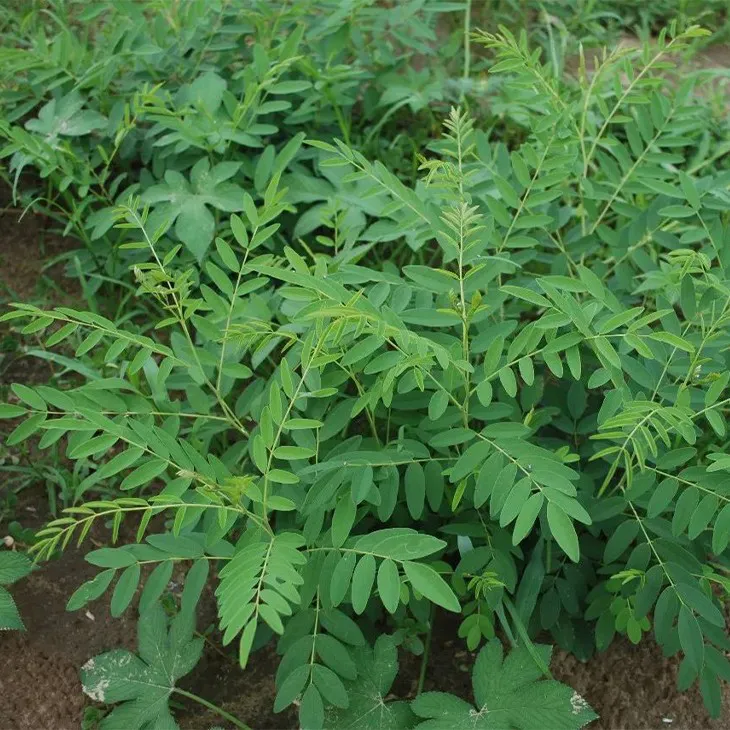- 0086-571-85302990
- sales@greenskybio.com
The flavor of mature Sophora flavescens roots and natural Sophora flavescens root extracts.
2024-11-12

1. Introduction
Sophora flavescens is a well - known plant in traditional medicine systems. The mature roots of Sophora flavescens have a distinct flavor, which is not only related to its chemical composition but also reflects its potential pharmacological properties. The natural extracts from Sophora flavescens roots are also of great interest due to their various beneficial effects. Understanding the flavor of the roots and the characteristics of the extracts is crucial for exploring their applications in medicine, cosmetics, and other fields.

2. Chemical composition of mature Sophora flavescens roots
2.1 Alkaloids
- Matrine and oxymatrine are two of the most important alkaloids in Sophora flavescens roots. These alkaloids contribute to the bitter taste of the roots. They also play significant roles in the pharmacological effects of Sophora flavescens, such as anti - inflammatory, anti - microbial, and anti - tumor activities.
- Other alkaloids like sophoridine also exist in the roots. These alkaloids together form a complex chemical profile that gives the roots their unique flavor and medicinal properties.
- Flavonoids in Sophora flavescens roots, such as rutin and Quercetin, not only add to the flavor but also have antioxidant properties. They can scavenge free radicals in the body, which is beneficial for preventing oxidative stress - related diseases.
- The presence of flavonoids also affects the overall taste profile of the roots, possibly contributing to a slightly astringent or earthy flavor note.
- Volatile compounds are responsible for the aroma of the Sophora flavescens roots. Although they are present in relatively small amounts, they play an important role in the overall flavor perception. Some volatile compounds may have a woody or herbal smell, which is characteristic of the roots.
- These volatile compounds can also have potential biological activities, such as insect - repelling or antibacterial effects, which are related to the ecological functions of the plant.

3. Flavor characteristics of mature Sophora flavescens roots
3.1 Taste
- The most prominent taste of mature Sophora flavescens roots is bitterness. This bitterness is mainly due to the presence of alkaloids, especially matrine and oxymatrine. The high concentration of these alkaloids gives the roots a strong and lingering bitter taste.
- There is also a certain degree of astringency, which may be attributed to the flavonoids. The astringency adds a dry and puckering sensation to the taste, making the overall flavor more complex.
- In addition, a faint earthy flavor can be detected. This earthy flavor is likely related to the root's origin from the soil and the presence of certain organic compounds that are characteristic of plants growing in the ground.
- The aroma of Sophora flavescens roots is rather unique. It has a herbal and slightly woody smell. The volatile compounds are responsible for this characteristic aroma. When the roots are dried or processed, the aroma may become more concentrated.
- Some people may also detect a faint musty smell, which could be due to the presence of certain metabolites or the result of the storage conditions of the roots.

4. Pharmacological effects of Sophora Flavescens Root Extracts
4.1 Anti - inflammatory effects
- The alkaloids in Sophora Flavescens Root Extracts, such as matrine and oxymatrine, have been shown to have anti - inflammatory properties. They can inhibit the production of inflammatory mediators, such as cytokines and prostaglandins. This makes the extracts potentially useful for treating inflammatory diseases, such as arthritis and dermatitis.
- Flavonoids in the extracts also contribute to the anti - inflammatory effects by scavenging free radicals and reducing oxidative stress, which is often associated with inflammation.
- The extracts of Sophora flavescens roots have antibacterial, antiviral, and antifungal activities. Alkaloids can disrupt the cell membranes of microorganisms, leading to their death. For example, they have been shown to be effective against certain bacteria that cause skin infections.
- Some volatile compounds in the extracts may also play a role in inhibiting the growth of microorganisms. Their antibacterial and antifungal effects make the extracts valuable for the development of natural antimicrobial agents.
- Studies have indicated that certain components in Sophora Flavescens Root Extracts, especially some alkaloids, may have anti - tumor activities. They can induce apoptosis (programmed cell death) in cancer cells, inhibit tumor cell proliferation, and prevent tumor angiogenesis (the formation of new blood vessels to supply the tumor).
- However, more research is needed to fully understand the mechanisms and potential applications of these anti - tumor effects in clinical settings.
5. Preparation methods of Sophora flavescens root extracts
5.1 Solvent extraction
- One of the most common methods is solvent extraction. Ethanol or methanol is often used as the solvent. The roots are soaked in the solvent for a certain period, and then the extract is obtained through filtration and evaporation. This method can effectively extract alkaloids, flavonoids, and other active components from the roots.
- The choice of solvent can affect the yield and composition of the extract. For example, different solvents may have different solubilities for different components, so it is important to optimize the solvent selection based on the desired components to be extracted.
- Supercritical fluid extraction, especially using carbon dioxide as the supercritical fluid, is a more advanced extraction method. It has the advantages of being non - toxic, environmentally friendly, and having a high extraction efficiency.
- This method can selectively extract certain components from the Sophora flavescens roots based on the pressure and temperature conditions. It can also preserve the bioactivity of the extracted components better compared to traditional solvent extraction methods.
6. Applications of Sophora flavescens root extracts in medicine
6.1 Traditional Chinese medicine
- In Traditional Chinese Medicine (TCM), Sophora flavescens root has been used for centuries to treat various diseases. The extracts are often used in the form of decoctions, pills, or ointments. For example, it can be used to treat skin diseases like eczema and psoriasis, where its anti - inflammatory and anti - microbial properties are beneficial.
- It is also used in the treatment of internal diseases such as diarrhea and dysentery, due to its ability to regulate the function of the digestive system.
- In modern medicine, researchers are exploring the potential of Sophora flavescens root extracts for the development of new drugs. The anti - inflammatory, anti - microbial, and anti - tumor effects of the extracts make them promising candidates for drug development.
- However, more pre - clinical and clinical studies are needed to ensure the safety and efficacy of these extracts. For example, studies on the pharmacokinetics and pharmacodynamics of the extracts are required to determine the appropriate dosage and administration routes.
7. Applications of Sophora flavescens root extracts in cosmetics
7.1 Anti - aging effects
- The antioxidant properties of flavonoids in Sophora flavescens root extracts can help prevent skin aging. They can scavenge free radicals that cause damage to skin cells, such as collagen and elastin fibers. This can reduce the appearance of wrinkles, fine lines, and improve skin elasticity.
- Some components in the extracts may also stimulate the production of fibroblasts in the skin, which are responsible for synthesizing collagen. This further contributes to the anti - aging effects of the extracts.
- For skin with inflammation, such as acne - prone or sensitive skin, the anti - inflammatory properties of the extracts can be very useful. They can reduce redness, swelling, and irritation of the skin.
- The extracts can also soothe the skin, providing a calming effect. This makes them suitable for use in products such as creams, lotions, and masks for sensitive skin.
8. Conclusion
The mature Sophora flavescens roots have a unique flavor, which is determined by their chemical composition. The natural extracts from the roots have a wide range of pharmacological effects and potential applications in medicine and cosmetics. However, further research is still needed to fully understand the mechanisms of action of these extracts, optimize the extraction methods, and ensure their safety and efficacy in various applications. With continued research, Sophora flavescens root extracts may become more valuable resources in the fields of health and beauty.
FAQ:
What are the main chemical components contributing to the flavor of mature Sophora flavescens roots?
The flavor of mature Sophora flavescens roots is related to various chemical components. For example, alkaloids such as matrine and oxymatrine are present. These alkaloids not only contribute to its characteristic taste but also play important roles in its pharmacological effects. Additionally, flavonoids and other secondary metabolites may also influence the overall flavor profile.
How are the natural Sophora flavescens root extracts obtained?
Natural Sophora flavescens root extracts can be obtained through several methods. One common approach is solvent extraction. Different solvents like ethanol or methanol can be used to extract the active components from the roots. Another method could be supercritical fluid extraction, which offers advantages in terms of selectivity and purity of the extract. The extraction process usually involves steps such as grinding the roots, soaking in the solvent, and then separating the extract from the solid residue.
What are the main pharmacological effects of the natural Sophora flavescens root extracts?
The natural Sophora flavescens root extracts have multiple pharmacological effects. They have been shown to have anti - inflammatory properties, which can be beneficial in treating various inflammatory diseases. Antimicrobial effects are also observed, making them potentially useful in fighting against certain infections. Moreover, they may exhibit antioxidant activities, which help in protecting cells from oxidative damage.
What are the potential applications of Sophora flavescens root extracts in the cosmetic field?
In the cosmetic field, Sophora flavescens root extracts have potential applications. Due to their antioxidant properties, they can be added to skincare products to prevent premature aging of the skin. They may also have anti - inflammatory effects on the skin, which can be helpful for treating skin conditions like acne or eczema. Additionally, the extracts might contribute to skin whitening effects, as some components may inhibit melanin production.
How does the flavor of mature Sophora flavescens roots relate to its quality?
The flavor of mature Sophora flavescens roots can be an indicator of its quality. A proper and characteristic flavor may suggest that the roots have been grown and processed correctly. Unusual or off - flavors could potentially indicate problems such as improper storage, contamination, or sub - optimal growth conditions. The presence of key chemical components responsible for the flavor is also related to the overall quality and efficacy of the roots.
Related literature
- Chemical Composition and Pharmacological Activities of Sophora flavescens."
- "The Potential of Sophora flavescens Root Extracts in Modern Medicine."
- "Sophora flavescens in Cosmetics: Properties and Applications."
- ▶ Hesperidin
- ▶ Citrus Bioflavonoids
- ▶ Plant Extract
- ▶ lycopene
- ▶ Diosmin
- ▶ Grape seed extract
- ▶ Sea buckthorn Juice Powder
- ▶ Fruit Juice Powder
- ▶ Hops Extract
- ▶ Artichoke Extract
- ▶ Mushroom extract
- ▶ Astaxanthin
- ▶ Green Tea Extract
- ▶ Curcumin
- ▶ Horse Chestnut Extract
- ▶ Other Product
- ▶ Boswellia Serrata Extract
- ▶ Resveratrol
- ▶ Marigold Extract
- ▶ Grape Leaf Extract
- ▶ New Product
- ▶ Aminolevulinic acid
- ▶ Cranberry Extract
- ▶ Red Yeast Rice
- ▶ Red Wine Extract
-
Europen Bilberry Extract
2024-11-12
-
Centella Asiatica Extract
2024-11-12
-
Black Garlic Extract
2024-11-12
-
Red Vine Extract
2024-11-12
-
Coconut Water Powder
2024-11-12
-
Andrographis Paniculata Extract Powder
2024-11-12
-
Agaricus Blazei Extract
2024-11-12
-
Thunder God Vine Extract
2024-11-12
-
Red Wine Extract
2024-11-12
-
Yellow Pine Extract
2024-11-12





















